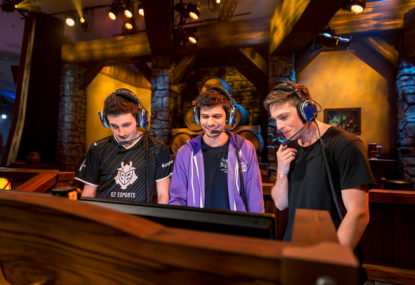For many of us, our experience with collectible card games started and ended with Pokémon – just looking, mind you, never actually playing. So how is that a virtual card game has turned itself into one of the biggest eSports in less than four years?
Hearthstone – formerly titled Hearthstone: Heroes of Warcraft – released in early 2014, featuring cards based on characters from Blizzard’s hugely successful Warcraft franchise.
Developers were initially fearful the public wouldn’t latch on to the idea, but now it sports a monthly playership of over 70 million people and its championship events are some of the biggest highlights on the eSports calendar.
We sat down with senior gameplay mechanics designer Dean Ayala, as well as prominent players Alex “Navi00T” Ridley and Anthony “Ant” Trevino to ask just what makes Hearthstone such a rich, competitive experience.
Ayala has worked on game balance Hearthstone since its first additional card set – Curse of Naxxramas in July 2014 – with his role since expanding to encompass “[all] the different systems that make up Hearthstone.”
When asked why the card game had managed to make such a mark on the eSports world, he offers some pretty interesting insights.
“I don’t think you can really go into a game saying, ‘I want to make an eSport, this game is going to be an eSport, and my primary goal is going to be to make this game and have many people watch it on TV’”
When you look at the lukewarm reception Sony’s Gran Turismo Sport – a title that heavily promised to put motor racing on the eSports map – received, his answer makes a lot of sense.
So how is it that a card game based off a fantasy franchise finds itself with an arguably bigger eSports scene that video games based on actual sports?
“Ironically, something that makes anything a fun, competitive thing to watch is that it has to have a population of people that are interested in this thing in the first place. So, for Hearthstone … you can watch your first game, and you can sort of understand in general what’s going on. It’s not too complex.
“Also, you need to have an amount of depth for the players that are coming back and playing for, you know, two years and then playing for like three or four hours a day.
“It’s just these two things that fight each other. You have to have a low enough amount of complexity where there’s enough people interested in your game and it’s easy to understand. Also, there’s an amount of depth without complexity that keeps players like Navi, Reynad and Toast and super interested and able to play for hours a day.
“In order to make a game like that there has to be a crazy amount of depth there. You have to be able to play for years and not gain total mastery over it. I think that’s where the eSport part comes.”
[latest_videos_strip]
Top players Navi00T, from Perth, and Ant, from the USA, have been on the scene for a very long time, with their large Twitch followings a testament to their Hearthstone mastery.
With backgrounds in both collectible card games and video games, Hearthstone seems like a natural fit for both – so why was this the title that inspired them to take their gaming further?
Their answers certainly make Ayala appear to be on the money.
“I’ve always wanted to be competitive. Hearthstone really has killed with that, with the ladder and your ranking and it changes after every game. You can always see how you stack up. Hearthstone is really good with that side of things,” Navi says.
“I think I’m the same way,” Ant says.
“You can actually compete online. What hooked me at first was the ladder system, where I got Legend, and then I came out pretty high, in 50.
“You can literally always get into a game, definitely. As long as you want, it’s statistically possible. You’ve just got to be yourself to get better.”
But while it’s easy to talk about why one enjoys playing a game, why do they think others enjoy watching it?
“For me, there’s so many things that make Hearthstone appealing. It might seem pretty simple and straightforward, but there are a lot of layers and complexities,” Navi says.
“You can talk about sample size, people’s play style. You can talk about deck building and where that comes into it. It’s real easy to get a big sample size. In other card games, it really isn’t, that’s really hard to do. It makes testing a lot harder. Hearthstone does a lot of work to make it fairly attractive.”
The Sydney Invitational took place recently, with interviewees Navi and Ant actually facing off in the first round.
Navi took the chocolates on this occasion – and actually went on to win the tournament.
While the tournament itself wasn’t played in front of a live audience, the raging success of the soiree the night before suggests future competitions will certainly have fans in attendance.
Ayala perhaps says it best when he says, “it takes so much time to master the difference between someone just starting out and someone who’s been doing it for years, it’s a huge difference.
“If it’s really popular you can go in after having played for a couple of months and you can see one of these players like Navi at the very top of the game and realise, ‘oh my god that person is extremely good at this. This is really entertaining to watch, because that is something I really enjoy, this thing that they’re doing, but I can’t accomplish what they’re doing. I want to watch somebody that’s the best.’”
Not too dissimilar to ‘real’ sports at all.





























































































